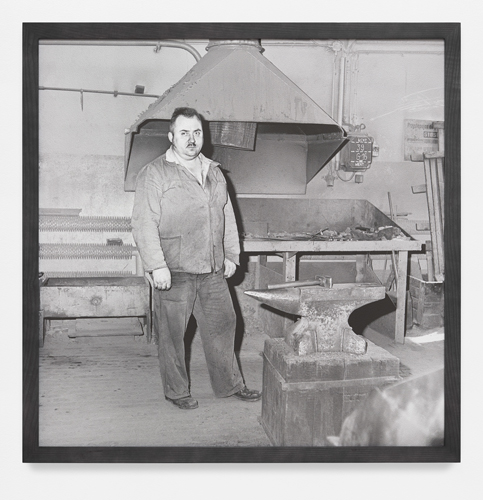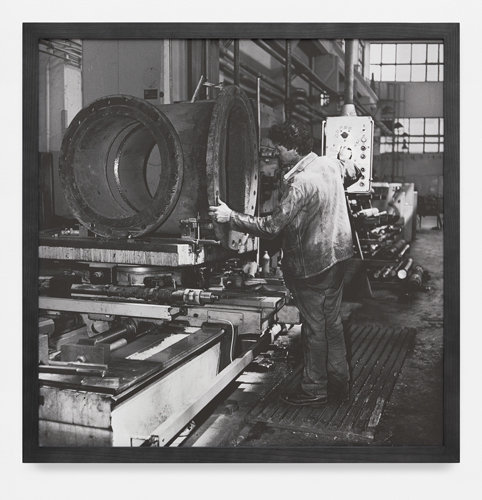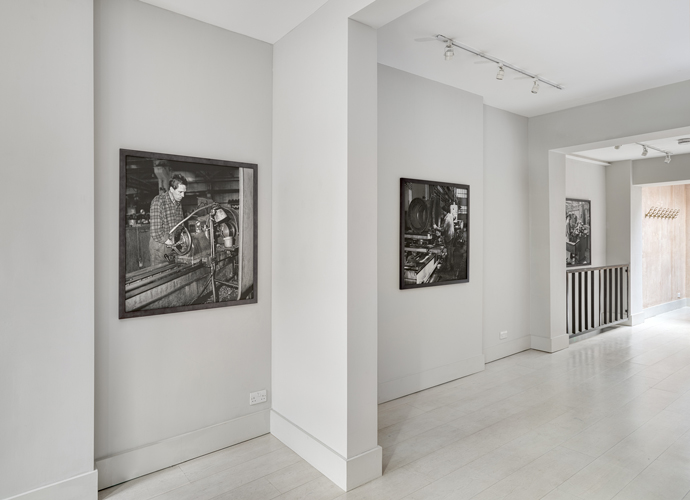









Craigie Horsfield: Workers
27 Nov 2015–26 Feb 2016Workers is Craigie Horsfield’s second solo exhibition with Large Glass. The exhibition comprises a series of photographs of Polish factory workers taken in Krakow in 1994, alongside a new text by Richard Cork. Below is an excerpt:
Before the invention of photography revolutionised our way of looking at the world, portraiture was largely confined to depicting the wealthiest and most powerful people in the world.
The men and women who dominated England during the Tudor period became especially addicted to showing themselves off in grandiose full-length paintings, where foppish attire often seems more important than their preening facial features.
Paintings of regal and aristocratic patrons could hardly be further removed from Craigie Horsfield’s images of Polish workers. No satire can be detected here, and the factories where they earn their living have nothing to do with ostentatious splendour. Horsfield’s decision to photograph them in black and white reinforces his refusal to prettify these grim locations in any way at all. They are forbidding places, inhabited by people who seem caught up in jobs demanding tough physical labour, long hours and very little remuneration. One of the workers, a moustachioed man, has laid down his hammer in order to straighten himself up and look away. But only for a moment: as soon as Horsfield has finished photographing him, this unsmiling man will doubtless resume his task once more.
As our eyes move from one image to the next, we realise that Horsfield’s empathy reveals just how isolated each of these individuals really is. The longer we gaze at them, the more stranded they become. At the same time, though, they refuse to feel defeated. Ultimately, Horsfield’s subtle ability to convey this sensitive insight means that we enter into their lives, and admire the resolve they maintain in order to cope with the demands of their daily predicament.
Before the invention of photography revolutionised our way of looking at the world, portraiture was largely confined to depicting the wealthiest and most powerful people in the world.
The men and women who dominated England during the Tudor period became especially addicted to showing themselves off in grandiose full-length paintings, where foppish attire often seems more important than their preening facial features.
Paintings of regal and aristocratic patrons could hardly be further removed from Craigie Horsfield’s images of Polish workers. No satire can be detected here, and the factories where they earn their living have nothing to do with ostentatious splendour. Horsfield’s decision to photograph them in black and white reinforces his refusal to prettify these grim locations in any way at all. They are forbidding places, inhabited by people who seem caught up in jobs demanding tough physical labour, long hours and very little remuneration. One of the workers, a moustachioed man, has laid down his hammer in order to straighten himself up and look away. But only for a moment: as soon as Horsfield has finished photographing him, this unsmiling man will doubtless resume his task once more.
As our eyes move from one image to the next, we realise that Horsfield’s empathy reveals just how isolated each of these individuals really is. The longer we gaze at them, the more stranded they become. At the same time, though, they refuse to feel defeated. Ultimately, Horsfield’s subtle ability to convey this sensitive insight means that we enter into their lives, and admire the resolve they maintain in order to cope with the demands of their daily predicament.